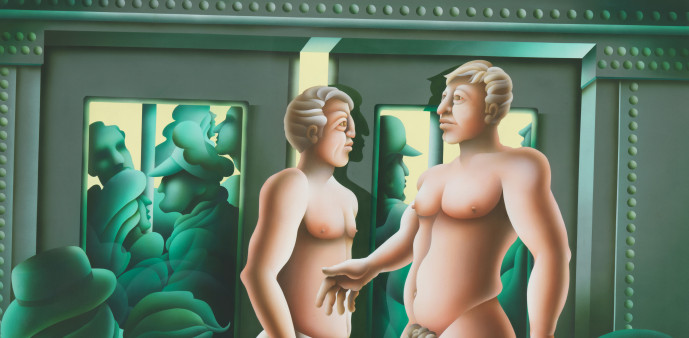Painter Jack Brusca earned critical praise since his first solo show in 1969 in New York City. Using an airbrush and acrylic on canvas, his signature style referenced pop art, surrealism, abstraction and the French artist Fernand Léger.
By the time he died of AIDS-related illness in 1993, three years before effecive HIV treatment became available, Brusca had also created acclaimed sets and costumes for the Alvin Ailey Dancer Theater in New York City and the Béjart Ballet in Brussels. In addition, he designed jewelry and interiors, including the original wall paintings at the Pavilion, a disco on Fire Island, the gay beach enclave outside New York City. (He also designed the club’s logo.)
View this post on Instagram
Art lovers in 2021 have a chance to experience (and purchase) some of Brusca’s work from now until December 18 at Daniel Cooney Fine Art in Manhattan. “While Brusca painted stylized abstractions and fantastical architectural renderings, this exhibition focuses solely on his incredibly lush and sexy figurative works,” reads the gallery’s press release for the show, titled Jack Brusca: Paintings 1975 — 1993. “Brusca’s voluptuous and finely muscled creatures live in the gloriously seedy New York City of the ’70s, ’80s and ’90s, the same location where Brusca blossomed and thrived as an artist.”
Below is a slideshow of several paintings from the gallery. You can view a more varied selection of his works on the Visual AIDS website, which is dedicated to artists living with and lost to HIV/AIDS. To learn more about Brusca, who was born in Queens, and the new exhibition, POZ emailed gallery director Daniel Cooney.
Based on the write-up accompanying the exhibit, it seems Brusca was active in New York City’s gay scene. Was he open about his sexuality, and did he ever explore that topic in his artwork?
I’m still learning about Jack’s personal life, as many of his comrades from that era have passed away. There is much evidence that he enjoyed life as an openly gay man both in his work and in documentation by other artists, such as Felice Picano’s writing about their time in Fire Island together. Artist Hunter Reynolds also created an incredible sculpture titled Jack Brusca’s Bed of Angels.
Similarly, was Brusca’s work ever concerned with HIV/AIDS?
Perhaps the most emotional and powerful work in the show is Brusca’s Self-Portrait, from 1993, which features the artist on his death bed surrounded by angels. Brusca pictures himself centered, lying in bed, thickly mustached, heavily tattooed and generously muscled. In the painting, he is gazing out an open window while surrounded by five angels representing friends who died before him. The most colorful and detailed angel who flies above is Frank Diaz, Brusca’s comrade and Fire Island roommate. Besides being painted by Brusca, Diaz famously served as muse to Robert Mapplethorpe.
What were the major themes, topics and styles of his work?
For his painting work, it seems that he created figurative, abstract and architectural works. Everything I have seen is acrylic airbrush on canvas, in addition to print editions he made.
How is Brusca’s work viewed by critics and collectors today?
There has been a great interest in learning about Jack’s work from collectors, curators and artists.
Finally, what draws you to Brusca’s work, and what makes it unique?
I find the technique and subject matter very attractive. He uses bold shapes and brightly saturated colors, and the technical skill is incredible. Beyond that, he is painting the New York that people remember and cherish from the ’70s and ’80s. People are nostalgic for the grit and joy of that time.
















Comments
Comments